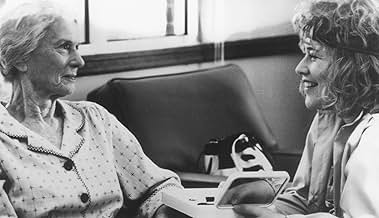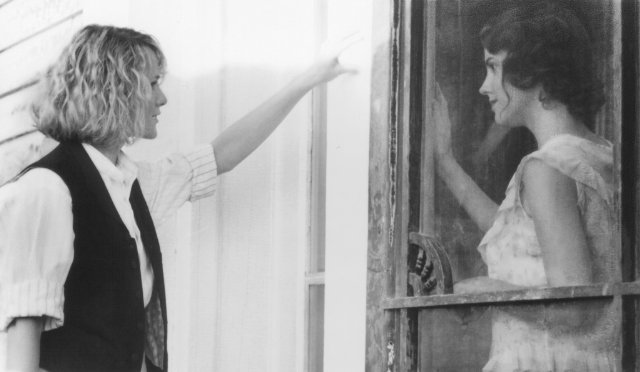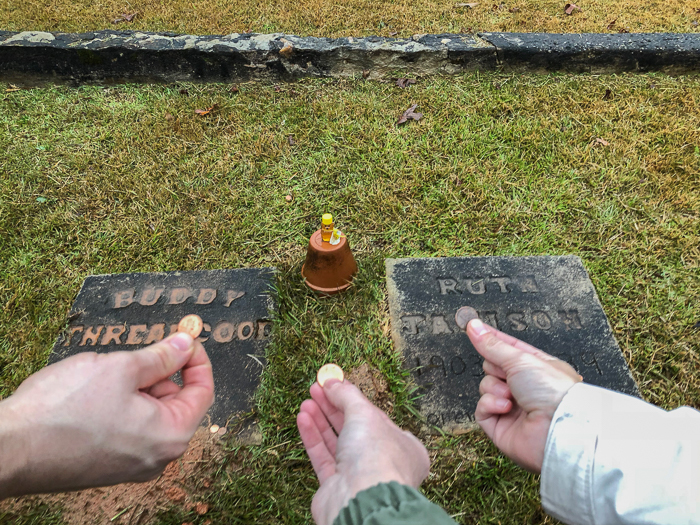
Friendship. Loss. Love that transcends time. Few films capture those emotions quite like Fried Green Tomatoes. Among its most unforgettable moments stands Ruth’s funeral scene — a quiet, rain-soaked farewell that left audiences in tears and cemented the film’s legacy as a story about eternal bonds between women.
Let’s dive deep into this iconic moment the emotion, the symbolism, the behind-the-scenes truth, and why it remains one of the most powerful depictions of friendship in cinematic history.
The Scene That Broke Everyone’s Heart
Picture this: a gray sky heavy with rain, a modest grave surrounded by wildflowers, and Idgie standing silently, holding a jar of honey. Without saying a word, she kneels and places the jar on Ruth’s grave — a small, tender gesture that carries the weight of their entire shared life.
It’s quiet, heartbreaking, and yet beautifully full of love. The rain isn’t just a backdrop; it feels like the sky itself is mourning with Idgie.

The Symbolism of the Honey Jar
The honey jar isn’t a random prop — it’s one of the film’s most meaningful symbols. Throughout Fried Green Tomatoes, honey represents sweetness, loyalty, and purity — all things that defined Idgie and Ruth’s bond.
Honey, after all, never spoils. It lasts for centuries. Just like Idgie’s love and devotion to Ruth.
That single jar speaks louder than any eulogy. It tells a story of two souls connected beyond time, beyond loss, and beyond societal boundaries.

Behind the Scenes: Real Rain, Real Emotion
Actress Mary Stuart Masterson, who played Idgie, revealed that the funeral scene was filmed under real rain, not staged effects. The director decided against artificial rain to preserve the raw emotion of the moment.
Masterson later said in an interview that shooting the scene under actual rain made it feel more spiritual — as if nature itself was part of the farewell. She didn’t need to fake tears; the rain and the grief blended naturally, creating one of the most authentic moments in the film.
Why Idgie Stayed Silent
One of the most powerful choices in the scene is silence. Idgie doesn’t speak a single word. No dramatic monologue, no tearful goodbye. Instead, her silence screams louder than words ever could.
Silence, in that moment, symbolizes acceptance. It’s not that Idgie has nothing to say — it’s that she’s said it all through her actions. She showed love through protection, laughter, and sacrifice. Now, she shows it one last time by letting go quietly.
A Cinematic Expression of Feminine Strength
This scene isn’t just about loss — it’s about strength. Idgie, once rebellious and fiery, stands grounded, weathered, and unbroken. The scene marks her evolution from a wild young woman into someone deeply human and wise.
The way she endures the rain, her stillness, her quiet defiance of grief — it’s an image of resilience that embodies feminine power. Not loud, not dramatic, but steady, dignified, and enduring.
The Power of Female Friendship in Film
During the early ’90s, Hollywood rarely depicted intimate female friendships with such emotional complexity. Fried Green Tomatoes changed that.
Idgie and Ruth’s relationship transcends labels — it’s friendship, it’s love, it’s kinship. And Ruth’s funeral scene distills it all into one timeless image: a woman mourning her soulmate, honoring her with a symbol of everything they shared.
The Rain: Nature’s Way of Mourning
Rain often symbolizes rebirth, cleansing, and emotional release. Here, it feels like nature is crying with Idgie. The gentle rhythm of raindrops mirrors tears — sorrowful yet beautiful.
It’s almost as if the world is acknowledging their story, washing away pain but preserving memory. Every drop of rain becomes part of their legacy.
Mary Stuart Masterson’s Dedication to Authenticity
Masterson’s decision to perform the scene without stunt doubles or stand-ins was a testament to her dedication. Even though it meant standing drenched and cold for hours, she insisted on doing it herself.
Why? Because Idgie wasn’t a character who’d hide behind comfort. She was raw, real, and unfiltered. And Masterson wanted every ounce of that truth to come through — and it did.
Symbolic Layers: Bees, Honey, and Memory
Throughout the film, bees and honey represent memory and the sweetness of life. Ruth’s grave, marked by honey, becomes a shrine to memory itself.
It reminds viewers that the most meaningful parts of life aren’t grand gestures, but small, sincere acts of love. Honey doesn’t just symbolize friendship — it immortalizes it.
From Script to Screen: How the Scene Was Born
Originally, the script featured Idgie giving a short speech at the grave. But during filming, director Jon Avnet and Masterson agreed to cut the dialogue. The visual — Idgie placing the honey — carried far more emotional depth than any line could deliver.
This last-minute creative choice turned the scene from a standard farewell into a masterpiece of subtle storytelling.
The Message of Eternal Connection
Even in death, Ruth remains with Idgie. The honey acts as a bridge between the living and the dead — a sweet reminder that love doesn’t vanish, it transforms.
The scene whispers a quiet truth: some bonds are eternal. They don’t fade with time; they crystallize, like honey sealed in glass.
Why Audiences Still Cry Watching It
Decades after its release, this scene continues to move viewers. Why? Because everyone has a Ruth. Everyone has lost someone they love deeply. And Idgie’s grief feels universal — quiet, unembellished, and painfully real.
It’s not a cinematic trick. It’s the kind of heartbreak that feels personal, no matter who you are.
The Cultural Legacy of the Scene
Ruth’s funeral scene has inspired countless discussions in film studies about gender, emotion, and symbolic storytelling. It’s often cited as one of the most beautiful examples of cinematic minimalism — where one small gesture can carry monumental emotional weight.
A Tribute to Love Without Boundaries
Ultimately, this moment is not just a goodbye — it’s a celebration. It’s proof that love, in its purest form, transcends gender, time, and even death.
Ruth and Idgie’s story reminds us that true friendship isn’t bound by labels — it’s defined by loyalty, courage, and the willingness to stand beside someone, rain or shine.
Ruth’s funeral scene in Fried Green Tomatoes is a cinematic poem — quiet, tender, and unforgettable. It teaches us that the greatest love stories are sometimes written in silence, sealed with honey, and remembered in rain.
As the rain falls and Idgie walks away, the world feels both emptier and fuller — emptier without Ruth, fuller with the memory of their bond.
FAQs
1. Why did Idgie place a jar of honey on Ruth’s grave?
Because honey symbolized their friendship — sweet, enduring, and pure. It was their personal emblem of love and memory.
2. Was the funeral scene filmed in real rain?
Yes. The cast and crew filmed it during an actual rainstorm to preserve authenticity and emotion.
3. Why didn’t Idgie speak during the scene?
Silence represented her acceptance and emotional maturity. Her gesture spoke volumes where words would have fallen short.
4. What does the honey represent in the film?
Honey stands for sweetness, loyalty, and timeless love — themes central to Idgie and Ruth’s relationship.
5. Why is this scene considered one of the best in “Fried Green Tomatoes”?
Because it perfectly combines emotion, symbolism, and simplicity — leaving an impact that lingers long after the credits roll.
